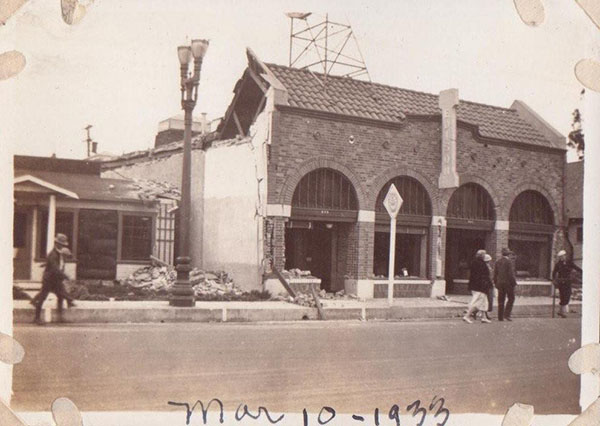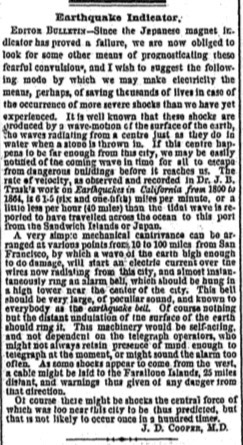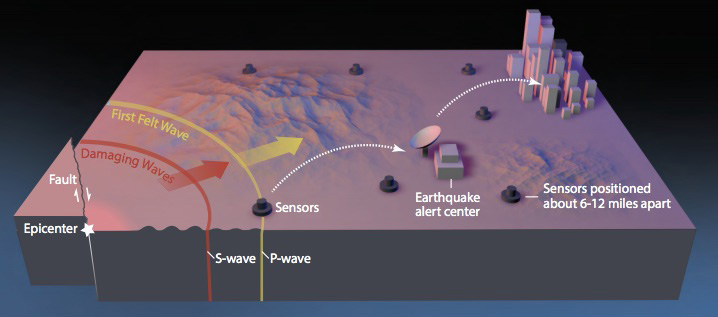1. West Coast earthquakes
People on the West Coast of the U.S. see movies about seismic disaster in their major cities. They read articles about forecasting and safety strategies. They retrofit their buildings, buy insurance, and worry. When I tell them about my research on earthquake early warning systems in Mexico, they ask me, “Why don’t we have something like that here?”
Networks of sensors arrayed across territory are set up around the world to register earth motion and send warnings to users speedily enough to warn them seconds or even minutes before the quake hits. Mexico’s was the first to make alerts available to the public almost a quarter of a century ago, and today there are similar systems around the world.
The fact is that we are going to have something similar on the West Coast, too, though it depends on how you define “we.” Tremendous strides have been made in the last few years toward in making a demonstration earthquake early warning system called ShakeAlert function across a frankly massive swath of seismic geography. The technology is promising, but the way that it will be used remains troublingly vague.
2. A simple mechanical contrivance

Image: The 1933 Long Beach earthquake spurred structural regulation reform. This photograph of the damage it caused is courtesy of US Geological Survey.
An earthquake early warning system was proposed in California almost a century and a half ago. California developed earthquake building codes and a system of structural review in the late 1920s and early 1930s in the wake of two particularly violent quakes. Today we have ongoing structural regulation refinements, updates on code and review procedures, the great California ShakeOut… and perhaps much of the West Coast of the US will see earthquake early warning, finally, in the next few years.
The original California earthquake early warning plan was published as a letter to the editor the San Francisco Daily Chronicle in 1868. J.D. Cooper, a medical doctor in the Bay Area, proposed what he called a “simple mechanical contrivance” that would use electricity to automatically ring a massive bell if an earthquake happened near enough that the city might feel its effects. “This bell should be very large, of peculiar sound, and known to everybody as the earthquake bell.”

Image: Cooper’s article in the San Francisco Daily Chronicle in 1868 has been recognized by geophysicists and engineers as the first published plan for earthquake early warning.
It is hard to know what this system would have looked like. The core of Cooper’s plan was the idea that people—at least, anyone who was in range of the bell’s ring, any hearing person, anyone who had the necessary knowledge, et cetera—could be warned when an earthquake was imminent. If you had to ask for whom the bell was tolling, it might still have been tolling for you… but here, attention to the machinery of the alert was clearly primary, while the ways in which “everybody” could learn about it did not rate much attention.
2. ShakeAlert and ShakeAlert users
The West Coast abuts the so-called “Ring of Fire,” where seismic motion is still both inevitable and unpredictable. That hasn’t changed since long before Cooper’s day. With incredible acts of calculation and coordination, however, new technologies can bring humans and seismic energy into relation in radically new ways. The ShakeAlert will have much more coverage than Cooper’s bell. It will give seconds or even minutes of warning, depending on the distance between quake epicenter and users at risk.

Image: Diagram from a 2014 fact sheet. Posted with permission from US Geological Survey.
Early warning systems can be a fantastically effective means to mitigate the destructive potential of earthquakes for industry and the general public. But throughout the development of this project, use cases have largely been left open. This openness is about potential, about leaving space for integration, and, indeed, about the resources that project leaders have at their disposal. While core system design efforts have largely focused on the development of new data care and analysis practices rather than on the particular mechanics of use cases, it is beta testers in private industry, local emergency services, and public transit operators who are considering how they could use ShakeAlert. According to the detailed technical implementation plan published in 2014, while ShakeAlert will use existing systems (many of which are not equipped to broadcast at the speeds required), the system will also rely on third parties.
3. West Coast worries
As a sometime-Californian and Cascadian, I am very pleased about the ShakeAlert’s potential. The work that has gone into building this system’s algorithms and communication system is the product of remarkable interagency and inter-institutional partnerships. It is estimated that it will cost $16 million per year with a $38 million initial rollout, and, despite political support, all that funding has been slower to materialize than one might wish. Without funding, so is the ability to make the system public.
Research on extant systems indicates that, paired with careful outreach and well-orchestrated education, earthquake early warning systems can not only save lives but reduce the trauma of an earthquake emergency (see Arjonilla 1989). But that cannot be achieved without systematic consideration of user needs and capabilities.
I worry about system users, and the extent to which they will be defined by external actors, often in private industry or local government entities. This means designing for users and educating them will be a matter of varied organizational goals, funding constraints, and cost-benefit analyses. I worry that, in realizing Cooper’s vision for the West Coast, his lack of engagement with users’ particular needs and capabilities will be recapitulated. The goals of inclusivity that animate ShakeAlert could be seriously compromised when users are dealt with, for all intents and purposes, off site and out of sight.
So if, after hearing about my research, you ask me why we don’t have an earthquake early warning system on the West Coast… then I worry that “we”—that is, a “we” that explicitly includes you and me—never will.
References
Arjonilla, E. 1998. “Evaluación de la Alerta Sismica Para la Ciudad de Mexico desde una perspectiva sociológica: resultados en poblaciones escolares con y sin alerta” presented at International IDNDR: Conference on Early Warning Systems for Reduction of Natural Disasters, Chile, April 27-30.
Burkett, E.R., Given, D.G., and Jones, L.M., 2014, ShakeAlert—An earthquake early warning system for the United States West Coast: U.S. Geological Survey Fact Sheet 2014–3083
Given, D.D., Cochran, E.S., Heaton, T., Hauksson, E., Allen, R., Hellweg, P., Vidale, J., and Bodin, P., 2014, Technical implementation plan for the ShakeAlert production system—An Earthquake Early Warning system for the West Coast of the United States: U.S. Geological Survey Open-File Report 2014–1097

1 Comment
Such a system may have great life saving potential. After spending much of past two years in Lane County Oregon and receiving briefs on The Cascadia earthquake scenario and aftermath, such a system may have merits. Should be discussed
1 Trackback